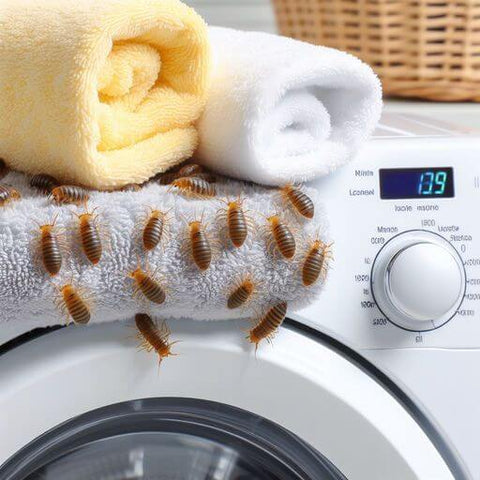Lice: 20 Surprising Facts and Myths
In a world where small creatures can pose a big problem, behind the seemingly harmless head lice lies a series of surprising facts and myths about lice waiting to be unraveled. Discover the hidden truths and myths that surround the world of head lice, and be surprised by what lies hidden in the mysterious world of these ticklish creatures.
As an experienced hairdresser with no less than 25 years of experience and expertise in hair and scalp problems, I am extremely skilled in identifying and treating lice. Over the years I have come across countless myths and facts. That is why I have neatly listed them all and would like to share my acquired lice knowledge with you. After reading these 20 fascinating facts and fables about lice, you will certainly no longer be framed. 🤣🤣

The 10 most famous myths about lice
1 . Myth: Wet combing is the best approach.
Answer : It is often said that wet combing is the best way to remove lice. However, this is not entirely true, because lice can also live in dry hair.
2. Myth: Lice like a clean head.
Answer: Although lice can more easily attach to long hair, this does not mean that they only occur on clean heads. Lice also feel at home on unwashed heads.
3. Myth: You should wash all bedding and clothing.
Answer: It is a common myth that you need to wash all bedding, stuffed animals and coats to remove lice. However, this is not necessary because lice do not spread through bedding or clothing. Read the extensive article about “Can lice survive in bed?”
4. Myth: Lice can survive in chlorinated water.
Answer: It is a myth that lice can survive in chlorinated water, but in reality they cannot.

5. Myth: Lice cannot survive in cold conditions.
Answer: Lice can survive in cold conditions, but they are less active at low temperatures.
6. Myth: Lice prefer certain hair types.
Answer: Lice do not prefer certain hair types and are at home on both short and long hair.
7. Myth: Lice cannot survive in cold water.
Answer: Lice can survive in cold water, but they are less active at low temperatures.
8. Myth: Lice cannot survive in the laundry.
Answer Lice can survive in the wash, but they cannot survive in hot water or a dry washing machine.

9. Myth: Lice can be transmitted from pets.
Answer: It is a common misconception that lice can be transmitted from pets to people. In reality, lice species that attack pets are not interested in humans and vice versa.
10. Myth: Lice can swim.
Answer: It is a misconception that lice can swim, but in fact they cling tightly to the scalp and are unable to swim, so your child can still go to swimming lessons even if he or she has lice.
These above myths are often heard and believed, but it is important to know the facts to deal with lice effectively.
My experience and knowledge about the 10 most interesting facts about head lice:
1. Fact: Girls have lice more often than boys.
Answer : Girls often have longer hair than boys, which makes it easier for head lice to attach to their hair. However, boys with long hair are just as likely to get lice as girls with long hair.
2. Fact: Lice cannot swim.
Answer: Lice cannot swim and instead cling more tightly to the scalp where they are located. So your child can just go to swimming lessons if he or she has lice.
3. Fact: Lice don't like clean hair.
Answer: A louse doesn't care whether you have just washed your hair or not. As long as there is hair on your head and warmth is provided, the lice feel at home.
4. Fact: Lice cannot be transmitted from pets.
Answer: Head lice that affect humans are not interested in pets and vice versa, so you don't have to worry about getting lice from your pet.
5. Fact: Lice cannot survive in clothing, stuffed animals and bedding.
Answer: Lice cannot survive without a human scalp. Once they leave the scalp, they become weakened and die quickly, so hot washing or freezing of textiles is not necessary.

6. Fact: Anyone can get head lice, even adults.
Answer: Anyone with hair, including adults, can get head lice because lice are transmitted through hair contact
7. . Fact: Head lice lay eggs, also called nits.
Answer: Nits are laid on a person's hair by female lice and are the size of a pinhead. They remain firmly attached to the hair until they hatch as young lice.
8. Fact: Lice cannot jump or fly.
Answer: Lice do not have jumping power or wings, so they cannot jump or fly to other people or objects.
9. Fact: Having lice has nothing to do with hygiene.
Answer: Head lice can occur on both clean and unwashed heads. It is purely about hair contact during transmission, not about hygiene level.
10. Fact: Head lice are not dangerous but they are annoying.
Answer: Head lice do not pose any serious health risks, but their bites can cause itching and irritation. Rapid treatment is therefore important to prevent further spread.
With these facts, you can better understand head lice and take more effective action in controlling and treating them
Finally:
Now that you have read the 20 most important and interesting facts and fables, you should now be able to take the Ultimate Lice Quiz effortlessly and error-free. Test your knowledge about head lice and take the Ultimate Lice Quiz now.
Tip: Order Dimeticon lotion from Luizenweg.nl now.
Sources:
